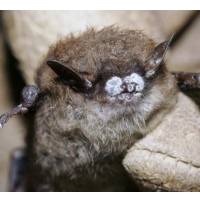U.S. Wildlife Service Accused of Caving to Timber Industry Pressure in Denying Protection for Endangered Bats
 Bat with white-nose syndrome (photo: U.S. Fish & Wildlife Service)
Bat with white-nose syndrome (photo: U.S. Fish & Wildlife Service)
By Ramona Young-Grindle, Courthouse News Service
WASHINGTON (CN) — A critical habitat designation for northern long-eared bats is "not prudent," Fish and Wildlife says, but environmentalists claim industry pressure is the reason protections were denied.
According to the U.S. Fish and Wildlife Service, it has declined to designate critical habitat for the bats because publishing hibernation locations would cause vandalism and disturbance at the sites and "hasten the spread of white-nose syndrome," a devastating fungus disease that has caused the bats' population to decline by up to 99 percent in the Northeast. Of all the bat species in the U.S., the northern long-eared has been the species most affected by the disease. The disease get its name from the white patches noted on the muzzles and wings of the bats.
"While critical habitat has a fundamental role to play in recovering many of our nation's most imperiled species, in the case of the northern long-eared bat, whose habitat is not a limiting factor in its survival, designating it could do more harm than good," Tom Melius, the Service's Midwest Regional Director, said. "Today's finding will ensure we don't put the bat at greater risk by drawing people to its hibernation sites. It also enables the Service and our partners to focus our efforts where they clearly can do the most good, finding a solution to the primary threat of white-nose syndrome."
The Center for Biological Diversity (CBD) conservation group, a frequent petitioner and litigant on behalf of imperiled species, was instrumental in having the northern long-eared bats listed as a threatened species in 2015, as a result of their 2010 petition. The bats were originally proposed for endangered status, but, the group claims, "intense industry pressure" caused the agency to list the species as threatened instead, with a special rule under Section 4(d) of the Endangered Species Act (ESA) that allowed activities that destroy the bats' forest habitat, such as logging, mining and energy development, to continue. Section 4(d) exemptions are not available for species with an endangered status.
The Fish and Wildlife Service maintains that white-nose syndrome is the most important threat to the bats, but the CBD claims that there is no evidence to support concerns that publishing a habitat designation would put the bats at greater risk of spreading the disease, while noting that the agency has effectively ignored habitat loss, which it initially acknowledged as a threat.
According to the CBD, scientific research demonstrates that species with critical habitat are twice as likely to recover as species without designated habitat, but the agency has used the "not prudent" and other loopholes to avoid giving critical habitat to many species. The ESA requires the Service to designate critical habitat for listed species unless it is not prudent to do so, is not within U.S. jurisdiction or is not determinable.
"If you don't protect the places endangered species live, it becomes that much harder to save them. This is yet another instance where the Fish and Wildlife Service has gone out of its way to appease special interests rather than protecting our most vulnerable animals," Tanya Sanerib, a CBD attorney, said. "To put it simply, the Fish and Wildlife Service isn't protecting habitat for the bat because it would be inconvenient for them to stand up to industry, not because it wouldn't benefit the bat."
Jill Utrup, a USFWS biologist, said that new information provided by state fish and wildlife agencies and other organizations with caves or mines used by bats within their jurisdictions, such as counties, the National Park Service, the U.S. Forest Service, conservation groups, and tribes, was factored into the agency's decision not to designate critical habitat for the bats.
According to the agency's announcement, white-nose syndrome was discovered in the state of New York in 2006-2007, and has since spread to 32 states and five Canadian provinces. In that time, it has claimed the lives of more than 6.7 million hibernating bats of various species in North America, according to the National Science Foundation, which sponsored research on the disease. White-nose syndrome is believed to have arrived in New York on the shoes of travelers from Europe, where the disease is widespread. Research has not so far revealed why it does not cause mass mortality in Europe as it does in North America, the NSF said.
Bats are important as pollinators and as bug-eaters. Bats "provide billions of dollars in economic benefit to farmers and foresters through the consumption of tons of insects nightly," the agency said.
To Learn More:
If You Think Times Are Tough for Pigs, Try Being a Bat (by Melanie Young, AllGov)
- Top Stories
- Unusual News
- Where is the Money Going?
- Controversies
- U.S. and the World
- Appointments and Resignations
- Latest News
- Musk and Trump Fire Members of Congress
- Trump Calls for Violent Street Demonstrations Against Himself
- Trump Changes Name of Republican Party
- The 2024 Election By the Numbers
- Bashar al-Assad—The Fall of a Rabid AntiSemite






Comments